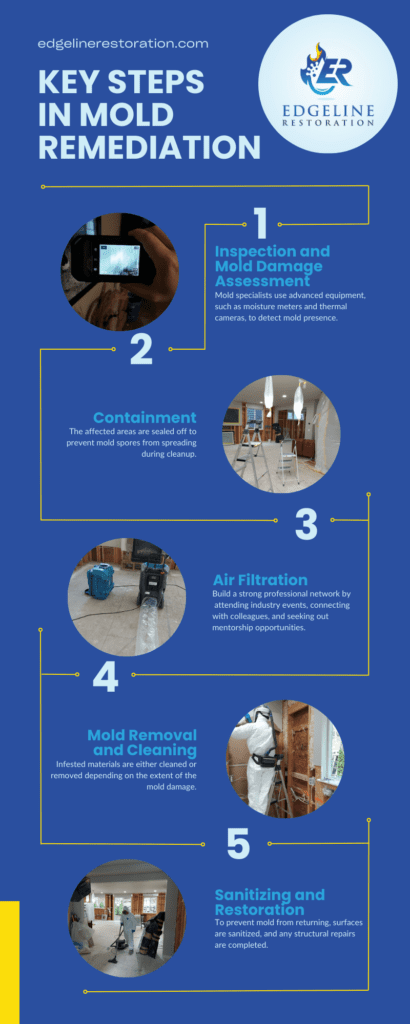
Emergencies such as water damage, fire incidents, mold growth, and storm destruction can turn your home or business upside down in a matter of minutes. The aftermath of these events often leaves property owners overwhelmed, unsure of what steps to take next. Emergency restoration services are designed to respond quickly, mitigate damage, and restore your property to its pre-loss condition as efficiently as possible.
Having a reliable restoration partner is crucial in Snohomish and King County, WA, where unexpected weather and structural issues can cause significant damage. Whether you’re dealing with the aftermath of a flood, a fire, or discovering mold in your home, immediate action can make all the difference. In this guide, we’ll cover everything you need to know about emergency restoration services, why a quick response is critical, and how to choose the right company to get your property back on track.
Understanding Emergency Restoration Services
Emergency restoration services are specialized responses that focus on repairing and restoring properties after sudden and severe damage. These services include water damage restoration, fire damage restoration, mold remediation, and storm damage repair, each requiring unique expertise, equipment, and procedures.
Restoration companies operate 24/7, understanding that emergencies don’t happen on a schedule. The goal is to minimize further damage, reduce recovery time, and ultimately lower costs associated with repairs and restoration. Key elements of emergency restoration include rapid assessment, damage control, cleanup, drying, repairs, and final restoration to pre-damage conditions.
Water Damage Restoration
Water damage is one of the most common types of property damage in Snohomish and King County, often caused by burst pipes, heavy rain, floods, or plumbing failures. Immediate action is crucial because water can quickly seep into walls, floors, and furnishings, leading to structural damage, mold growth, and costly repairs.
Key Steps in Water Damage Restoration:
- Assessment and Inspection: The restoration process begins with a detailed assessment to identify the extent of the damage and the type of water involved (clean, gray, or black water).
- Water Extraction: Powerful pumps and vacuums are used to remove standing water from the property, preventing further damage.
- Drying and Dehumidification: Industrial-grade dehumidifiers and air movers are deployed to eliminate moisture from walls, floors, and other affected areas.
- Cleaning and Sanitizing: Depending on the severity of the damage, contaminated items are cleaned, disinfected, or discarded.
- Restoration and Repairs: Final steps include repairing or replacing damaged materials, such as drywall, flooring, and insulation.
Fire Damage Restoration
Fires are devastating, leaving behind charred materials and smoke damage, soot, and odors that can permeate your entire property. Whether caused by electrical faults, kitchen mishaps, or external factors, fire damage requires a thorough and strategic approach to restoration.
Key Steps in Fire Damage Restoration:
- Inspection and Assessment: The first step involves assessing the extent of fire, smoke, and soot damage, allowing the team to plan the restoration process effectively.
- Board-Up and Roof-Tarp Services: Restoration companies may board up broken windows and provide roof tarping to prevent further damage from weather or vandalism.
- Soot and Smoke Removal: Special techniques and equipment are used to remove soot and smoke from walls, ceilings, and other surfaces.
- Odor Removal: Advanced deodorization tools are employed to eliminate lingering odors, ensuring the air quality in your property is safe.
- Restoration and Repairs: This includes repairing or replacing drywall, painting, and rebuilding areas severely affected by the fire.
Mold Remediation
Mold growth is a common consequence of water damage and high humidity levels, often hidden behind walls, under carpets, or in basements. Mold not only affects the appearance of your property but also poses serious health risks, including respiratory problems and allergies.

Key Steps in Mold Remediation:
- Inspection and Mold Damage Assessment: Mold specialists use advanced equipment, such as moisture meters and thermal cameras, to detect mold presence.
- Containment: The affected areas are sealed off to prevent mold spores from spreading during cleanup.
- Air Filtration: HEPA filters are used to capture mold spores from the air, improving air quality and protecting occupants’ health.
- Mold Removal and Cleaning: Infested materials are either cleaned or removed depending on the extent of the mold damage.
- Sanitizing and Restoration: To prevent mold from returning, surfaces are sanitized, and any structural repairs are completed.
Statistics: According to the CDC, prolonged exposure to mold can cause severe health problems, particularly in individuals with asthma, allergies, or compromised immune systems.
Storm and Flood Damage Repair
Storms and floods can cause extensive damage to homes and businesses, from roof damage due to high winds to flooding caused by heavy rain. Restoration teams work quickly to address the immediate threats posed by storm damage, preventing further destruction.
Key Steps in Storm and Flood Damage Repair:
- Emergency Tarping and Board-Up Services: Protects the property from further exposure to the elements.
- Water Extraction and Drying: Removes standing water and thoroughly dries all areas to prevent mold growth.
- Debris Removal and Cleanup: This involves removing fallen branches, broken glass, and other debris caused by the storm.
- Structural Repairs: Fixes damaged roofs, walls, and other critical structures to restore safety and functionality.
Importance of Quick Response
A quick response in emergency restoration is critical to minimizing damage and lowering overall repair costs. Delays can lead to secondary damage, such as mold growth, structural weakening, and permanent property loss. Professional restoration companies are equipped with advanced tools and trained personnel to tackle these challenges swiftly.
Statistics: Studies show that immediate action within the first 24-48 hours can reduce the overall water and fire damage restoration cost by up to 40%.
Choosing the Right Restoration Company
Selecting the right restoration company is essential to ensure a smooth and successful recovery. Look for companies that are IICRC-certified, have 24/7 availability, and offer a proven track record in emergency response.
Key Considerations:
- Certifications: Ensure the company holds industry-recognized certifications.
- Experience and Reputation: Check reviews and ask for references to verify their expertise.
- Availability: A reliable restoration company should be available 24/7 to respond to emergencies.
Conclusion
Emergency restoration services are your best ally in recovering from unexpected property damage. Whether facing water damage, fire devastation, mold growth, or storm impacts, prompt and professional restoration can help protect your investment and bring peace of mind. If you’re in Snohomish or King County and need immediate assistance, don’t hesitate to contact Edgeline Restoration for fast, reliable, and comprehensive services.
FAQ
What should I do immediately after water damage?
Immediately shut off the water source and contact a professional restoration company if possible.
How long does the fire damage restoration process take?
The duration depends on the extent of the damage, ranging from a few days to several weeks.
Can storm damage be prevented?
While storms can’t be controlled, proper maintenance, like roof inspections, can minimize damage.
How do I choose an emergency restoration company?
Look for certifications, reviews, and a prompt response time to ensure quality service.
What certifications should restoration companies have?
Certifications like IICRC (Institute of Inspection Cleaning and Restoration Certification) are highly regarded.





